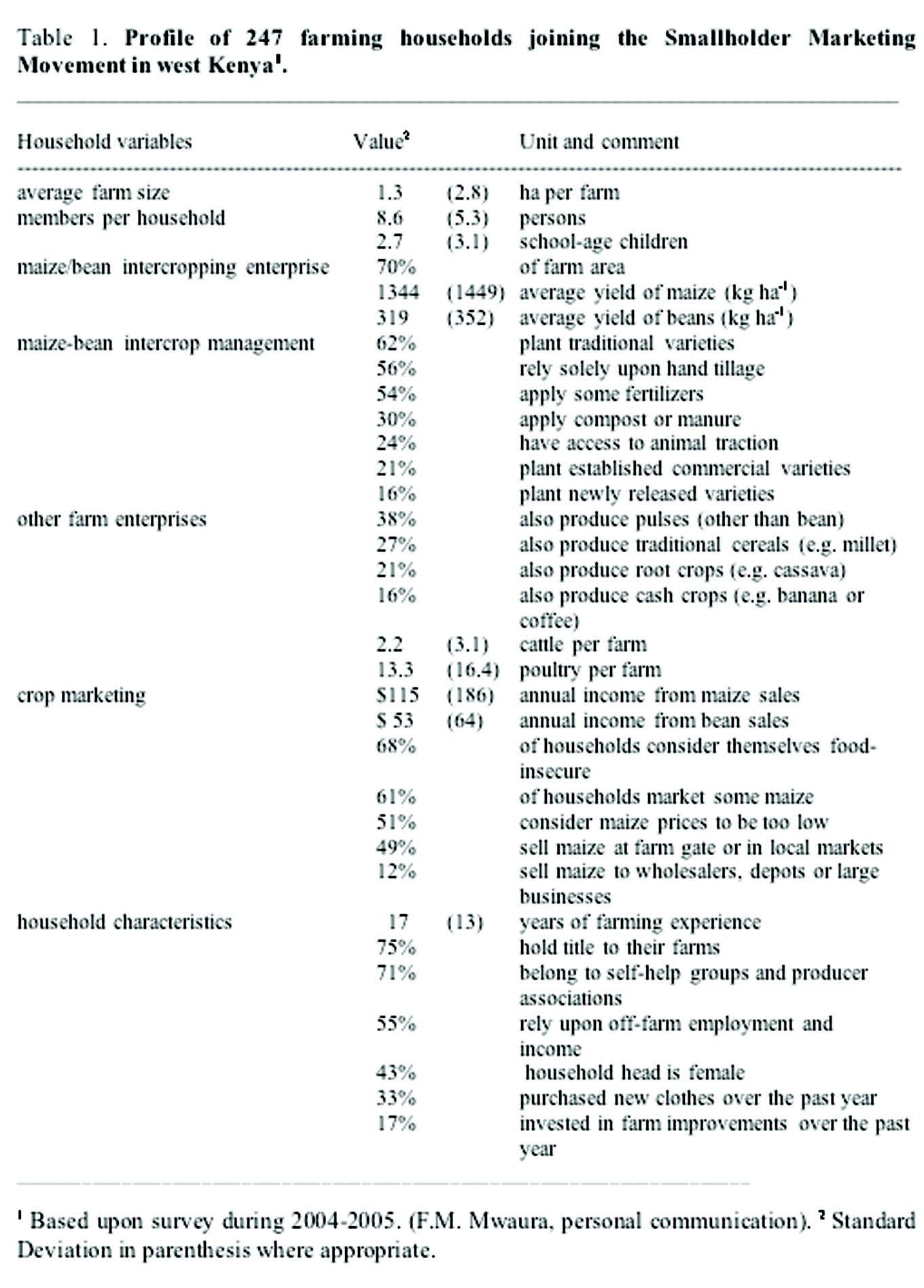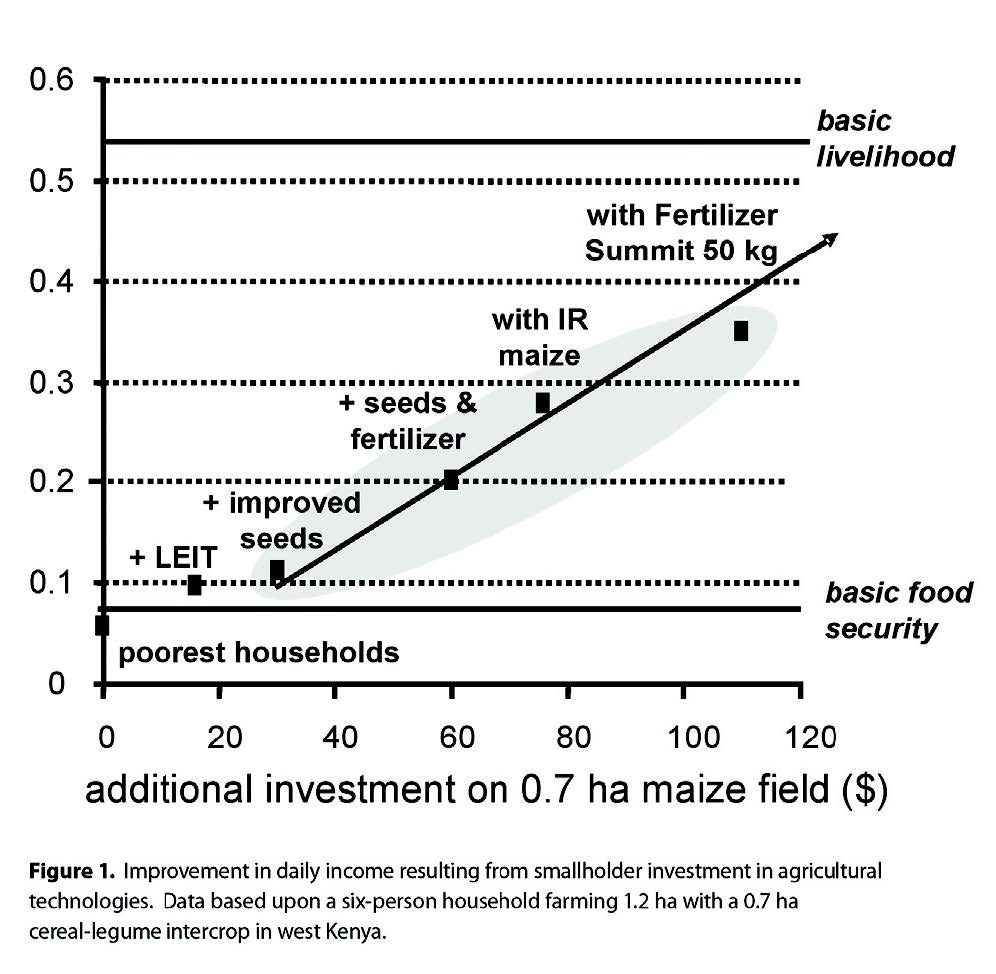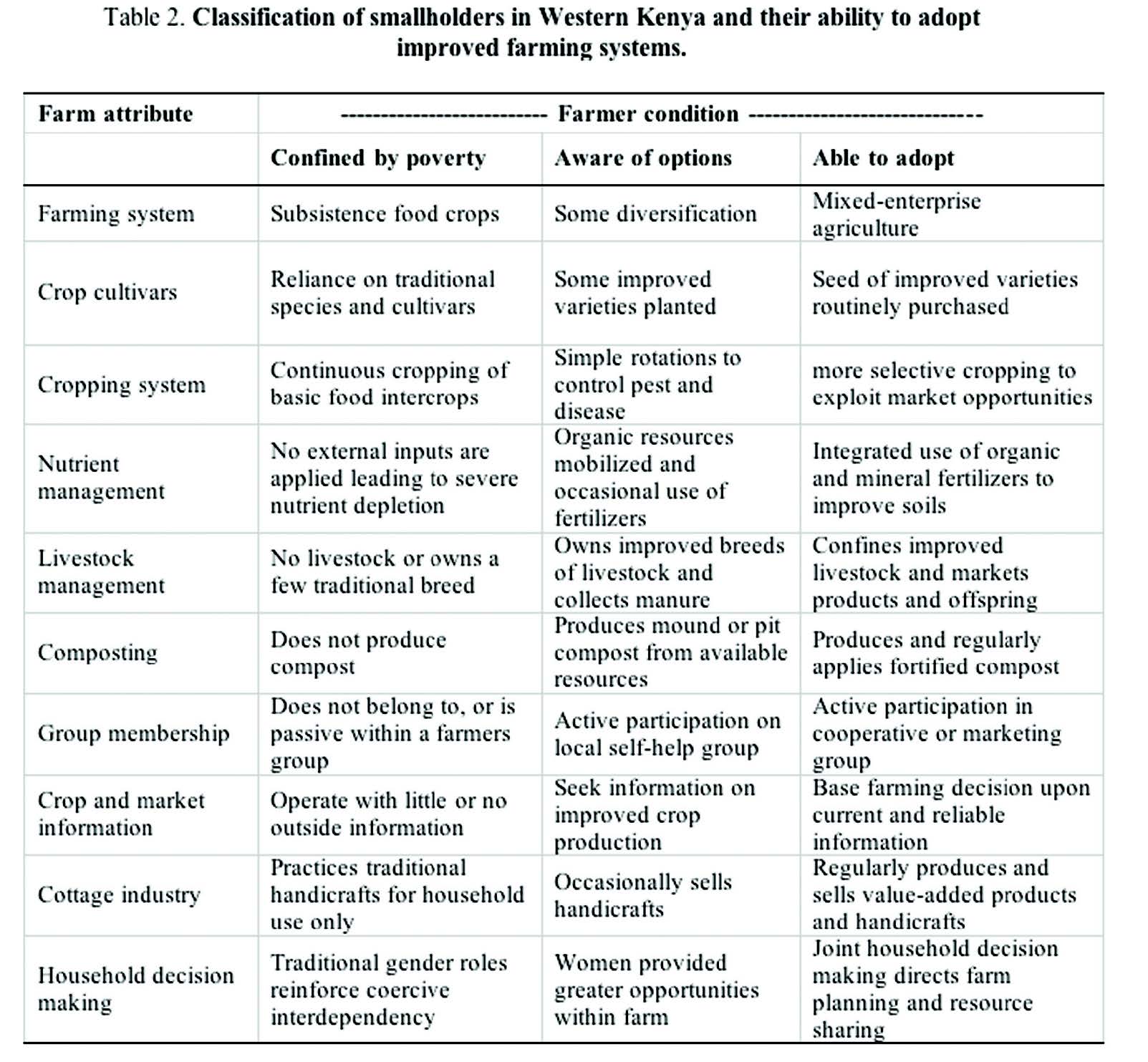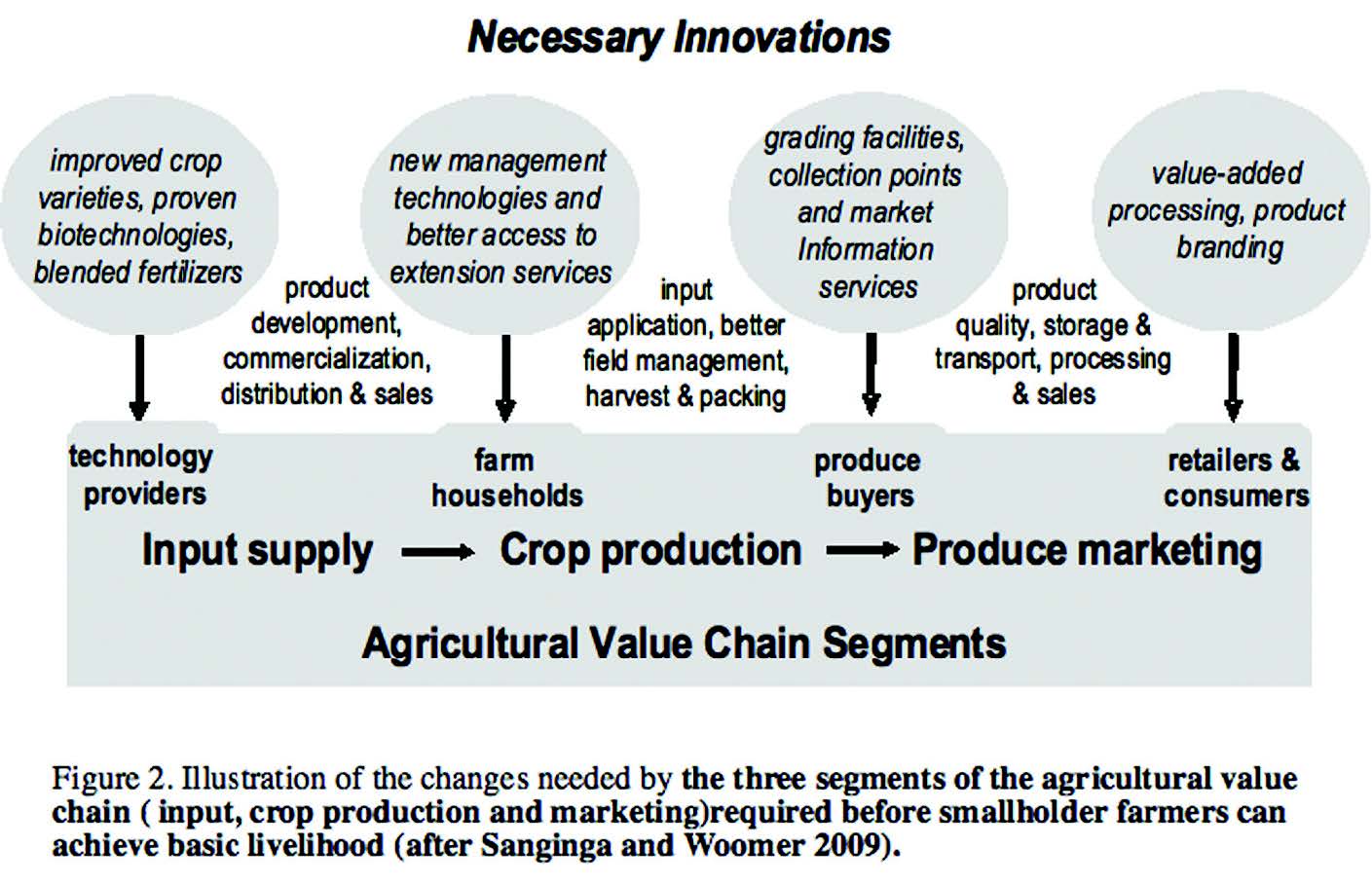New Horizons for Small-scale Farming in East Africa
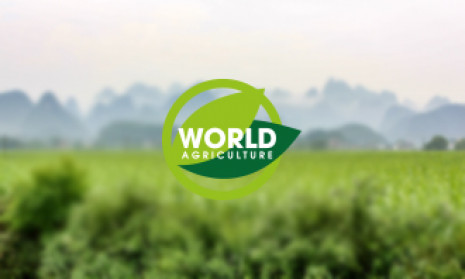
Summary
Small-scale farming in East Africa is in transition from a subsistence to a market-based agriculture, as households recognize that many of their needs cannot be satisfied directly from the land. This is the latest phase in a passage from pastoral migration through tribal settlement, colonial domination, national independence and economic stagnation and recovery. Smallholders are responding to rising aspirations through participation in self-help and producer organisations to develop new farm enterpris- es and access better information, improved technologies and fairer markets. Adjusted approaches by development agencies also reflect smallholders’ aspirations, particularly the promotion of markets which add value by considering farm input supply and more productive farming practices. Opportunities opening to smallholders include access to improved crop cultivars and seed, mineral fertilizers, informa- tion on management of pests and diseases, increased use of biological nitrogen fixation and collective marketing. The ideal of establishing “sustainable small-farm economies” built upon food security for the individual family and “green” environmental management skills alone is too restrictive, as it fails to recognize farmers’ aspirations. The realisation of broader, more socially equitable approaches to rural development depends on the flexibility of farmers to respond to changing production techniques and market opportunities.
Origins of Smallholder Farming in East Africa
Smallholder farming systems in East Africa are undergoing a profound transformation from provision of fami- ly subsistence to a mixed-enterprise, market-oriented agriculture. This tran- sition may be abrupt, as when small- holders join organized ventures which contract farmers to produce a specific commodity, offer a guaranteed mar- ket, assume responsibility for quality control and often extend credit to assist farmers to meet their contractual obligations. In most cases, however, the transition is subtle as households recognise that their needs cannot be satisfied by farming in isolation, and they make stepwise adjustments to improve their production and market- ing skills (Woomer et al. 1998).
Permanent and intensive cultivation of small areas of land has developed relatively recently. Africa, especially eastern and southern Africa, has undergone a series of pastoralist migrations from West and Northern Africa (Oliver 1982). Once new lands suitable for livestock and farming were secured, these migrants cultivated small areas of land, and practiced long-term, grazed fallow rotation. (Boonman 1993). Households raised a wide variety of indigenous crops and gathered traditional green vegetables and fruits (Maundu et al. 1999). Livestock were viewed as wealth and complex patterns of communal graz- ing and gift exchange developed around them. As population increased, a larger proportion of land was placed into cultivation and fallow intervals decreased until, in the most densely populated areas, fallowing and com- munal grazing ceased (Woomer et al. 1998).
At the earliest stages of European and Arab contact, new crops, particu- larly maize, beans, groundnut and cas- sava, were introduced and adopted rapidly as land use intensified. The invasion of white colonialist farmers interrupted this process in many parts of East and South Africa. Some colo- nialists displaced Africans from the best agricultural lands and, in many cases, forced them to become labour- ers on large plantations (Odin
1971).
This invasion was short-lived, ending for the most part with independence, although it has left behind a mixed legacy of new cash crops, farming methods, infrastructure and land tenure. Many traditional crops and farming practices were lost and land reallocation was somewhat irregular.
It was against this backdrop that today’s smallholder farming developed in East Africa.
Decades of Disadvantage
Newly independent African govern- ments often sought to stimulate their economies through the development of state regulation of agricultural products (Eicher 1999). Produce boards were intended to improve access to markets and be a basis for raising taxes from smallholding agri- culture. Their highest priority was to reinforce export crops, such as coffee and tea, to secure foreign currency for industrial development, but many of the basic needs of smallholders were overlooked. (Alexandros 1997). This lack of commitment to the poorest is partly responsible for the failure of the so called Green Revolution to take root in Africa in the 1970s (Okigbo 1990), leading to the chronic food insecurity and episodic famine which characterizes much of recent African history.
Governments established agricultural extension services, marketing boards, farmers’ associations, credit schemes, faculties of agriculture and national research institutes. These have princi- pally benefited the larger farms. The services of these bodies were weak- ened by budget deficits and inflation during the 1980s. Many produce and marketing boards fell into mismanage- ment (Alexandros 1997). Donor insti- tutions imposed structural adjustments that resulted in dismantling or privatis- ing these bodies and liberalisation of national agricultural economies in the early 1990s. Unfortunately many of these reforms did not achieve the desired growth as private sector investment failed to materialize, leav- ing little to fill the rural services vacu- um (Eicher 1999).
Following independence in the 1960s, little changed for the vast majority of smallholder farmers, except that their numbers increased greatly, their farm sizes diminished and their soils degraded, so that sea- sonal food shortages intensified. Governance may be improving in Africa as a result of democratisation and market reform during the 1990s, but few of these benefits have yet to penetrate to small-scale farming households. Some smallholders became demoralized, others relocated to urban areas seeking menial employ- ment, but the majority sought to make the best of their situation, often forming local marketing groups to access better information and take col- lective action. A profile of such small- scale farm households in west Kenya is presented in Table 1 (derived from Sanginga and Woomer 2009).
Opportunities
The future of these small-scale farming households largely rests on their ability to innovate and seize new production and marketing opportunities. National planners and development agencies can also support farmer cooperation. There are hindrances beyond smallholders’ control, notably poor rural roads and scarce utilities, which increase input and marketing costs. The provision of agricultural advice is sporadic and attempts at reform of the agricultural extension services are largely ineffective. The increase in the number of small farms and large num- ber of potential clients makestraining and farm visits difficult. The frontline extension services lack sufficient resources to assist their nearby clients (Lynam and Blackie 1994). Improved information services via internet serv- ice providers may partly redress this situation, but require a huge invest- ment in hardware and training. One emerging success story is the collec- tion and availability of price data through cellular phone Short Message Service (SMS; Mukhebi et al. 2007; Nambiro et al. 2008).
Smallholders do not accept their dis- advantages passively, nor do they respond by thoughtlessly destroying their agricultural resource base (Tiffen et al. 1994; Woomer et al. 1998) as is sometimes suggested (see Bursch et al. 1997). Owing to the weakness of formal agricultural extension services many farmers have formed communi- ty based organisations to improve access to information on new farming techniques and products. Farmers rec- ognize the benefits of improved culti- vars, the need to improve soil fertility, and to make modest investments in their farms according to the availabili- ty of cash and credit as Table 1 illus- trates. Too often this cash comes as remittances from family members, usually young adults working in menial jobs in distant urban areas. Their absence also erodes the availabil- ity of labour and youthful enthusiasm for farming. Nonetheless, most small- holders have adjusted their farming to become more diversified toward local markets and more integrated by mak- ing better use of limited resources such as crop residues, legume rota- tions and organic fertilizers (Gachene and Kimaru 2003), as well as small amounts of purchased inputs (Crowley and Carter 2000; Woomer 2007).
There are signs of real advances and potential improvement in the lives of small-scale farming households. There has been a 2.2-fold improvement in agricultural output over the past decade (Omamo 2006) which has reduced the trend of agricultural stag- nation in East Africa. Other advances include greater access to improved cultivars, better soil and pest manage- ment (Conway and Toenniessen 2003), expansion of services to mem- bers of farmer associations (Stringfellow et al. 1997) and the emergence of collective marketing networks which address basic food commodities, export markets and spe- cialty crops such as organic produce (Muturi 2001).
Improvements
Improved cultivars, seed production and distribution systems are becoming increasingly available to African small- holders as seed markets are liberalized and private sector investment increas- es. Disease resistant cereals, legumes and root crops that were developed by collaborating research organisations have now passed through national regulators and are available for commercial release through a vari- ety of mechanisms (Speilman et al. 2007). Particularly significant traits include resistance to maize streak, cas- sava mosaic (DeVries and Toenniessen 2001) and groundnut rosette viruses, and the promiscuously nodulating soybean, that does not require rhizo- bial inoculants to establish effective nodulation under most African field conditions (Mpepereki et al. 2000; Sanginga et al. 2002). These comple- ment the existing field school net- works offering expertise on integrated pest management (Okoth et al. 2006). In some cases, improved cul- tivars stimulate accompanying tech- nologies, such as the deployment of herbicide-resistant maize for control of the plant parasitic weed striga (Kanampiu et al. 2002; Woomer et al. 2008). Other indicators of improve- ment include the cultivation of higher value vegetable crops, establishment of woodlots and orchards, improved rearing of farm animals and the for- mation of value-added cottage indus- tries (Savala et al., 2003). Improving decision making for planning and allo- cation of resources within households is another important indicator that farming is seen as a business rather than a survival strategy (Kaaria et al., 2008). This adjustment con- trasts greatly with divisive views that consider men and women in farming households oper- ate in separate spheres of coer- cive interdepend- ency (Evers and Walters 2000).
There are also promising signs of economic reform and policy change. One exciting develop- ment is the con- sensus to improve links between farmers, input suppliers and commodity buyers. This motivates farmers to invest in new technology and intensify farm man- agement through access to more prof- itable markets (Hazell et al. 2007).
This approach follows disappointing experiences of developing and pro- moting seemingly appropriate produc- tion technologies, only to have them rejected by poor, risk-adverse farmers (Eicher 1999; Kelly et al. 2003).
Improvements to the input supply chain through networks of local stock- ists can increase demand for improved seeds and fertilisers (Kelly et al. 2003). Incentives to raise demand for farm inputs include community banking, ‘smart subsidies’ through the distribu- tion of vouchers for key inputs and improving credit within farmer organi- zations. Community cereal banks pro- vide members with access to higher priced markets during periods of crop surplus but ensure that staple food will be locally available later in the season. Rural development policies have increasingly assumed more holistic approaches, leading to the Millennium Development Goals (Juma 2006). These include eradicating extreme poverty and hunger, achieving univer- sal primary education, empowering women, reducing child mortality and improving maternal health and dis- ease. The attainment of these goals is being evaluated by monitoring a net- work of Millennium Villages, resulting in significant but mixed success (Cabral et al. 2006). Extension can also be improved as qualified rural development project managers may now be drawn from national universi- ties which recognise the combination of skills required to stimulate rural change. The necessary degree curricu- la have been restructured (Patel and Woomer 2000).
Another novel approach is the iden- tification of local leading innovators and Early Adopters as ‘master’ farmers. These are provided with periodic train- ing and topical practical information that stimulates farmer-to-farmer dis- semination of less knowledge-intensive technologies (Sanginga and Woomer 2009).
Fertiliser needs
The Africa Fertilizer Summit recently adopted the Abuja Declaration on Fertilizer for an African Green Revolution. This plans for a six-fold increase in fertiliser use in Sub-Saharan Africa over the next decade (Africa Fertiliser Summit 2006). The Alliance for a Green Revolution in Africa (AGRA) has initiated a well-endowed African Soil Health Initiative to help meet this goal by promoting Integrated Soil Fertility Management (Vanlauwe 2004; Sanginga and Woomer 2009), and linking it to improved seed systems, produce mar- kets and extension information. The World Bank recently published a set of good practice guidelines to stimulate fertilizer supply and demand (Morris et al. 2007).
One key to achieving these targets is the increase of biological nitrogen fixa- tion (BNF) by grain legumes (Giller 2001). Large amounts of nitrogen are required by African soils because the nutrient is widely limiting and is con- tinuously lost in harvest produce, ero- sion and leaching (Smaling et al. 1997). Grain legumes are extremely important within smallholder systems as sources of protein and fodder but their nitrogen fixing systems typically under-perform, annually providing only 38 kg N/ha (see Giller 2001). Alternatively, increasing BNF to 84 kg N/ha is an achievable option but requires investment in other fertiliser sources, particularly phosphates avail- able throughout the continent and fer- tilizer blends that ensure nitrogen is not limiting (Van Straaten 2002).
Escaping Poverty
The drive towards sustainable agricul- ture in Africa was the ideal for house- holds to be food and nutritionally secure and independent of external farm inputs (Tripp 2006). From the donor and national planning perspec- tive, these may represent desirable and achievable aspirations. However, from the perspective of the individual household, this represents a poverty trap which reduces aspiration and leaves households with insufficient spare cash to secure education and health services and modest amenities such as bicycles, electricity, radios or telephones. These households are sus- tainable in an agro-ecological context but not from a socio-economic per- spective.
A more robust definition of smallholder prosperity is forming that more effectively meets the needs and aspira- tions of rural households (UN Statistics Division 2005). Food security is obtained through the production of staple crops, while income is generat- ed from cash crops, livestock and value-added processing (Crowley and Carter 2000; Savala et al. 2003). In many cases, the staple and cash crops may be the same, for example, dried grains which can be processed, stored and marketed when prices are favourable. Timely access to key farm inputs and the availability of fair mar- kets are essential parallel conditions to this prosperity.
One aim of the Millennium Development Goals is to reduce the proportion of the world’s population living in extreme poverty (on less than $1 per day) by 50% between 2005 and 2015. Between 1990 and 2005 the number of extremely poor was reduced by 25% in Asia and Latin America but it increased in Sub- Saharan Africa (Cabral et al. 2006). Basic food security is achieved at a very low level of income (Woomer 2006, 2007). For example, in west Kenya, it requires only US $0.08 per person per day to consume 100 kg of maize and 30 kg of beans per year (Fig. 1; Low external input technolo- gies, LEIT). This diet is complemented by edible leaves and seasonal fruits. In contrast, a basic livelihood including meat, eggs and milk requires about $0.54 per person per day including $50 per household per month for medicine, school supplies and cloth- ing. Daily income beyond $0.54 is then available for home and farm improvements, investment in new enterprises and modest savings. This analysis was performed using a smaller set of farm households with similar, but slightly fewer, resources than those described in Table 1. Large households (9+ members) on small farms (> 0.4 ha) find it nearly impossi- ble to meet livelihood goals through mixed agriculture (Woomer, 2006). From this analysis it is also clear why so many households practicing subsis- tence agriculture must rely upon high- er value crops, off-farm employment and remittances from absent family members (Table 1).
The relationship between innovative farm technologies and income is pre- sented in Fig. 1. LEIT require environ- mentally sustainable but labour inten- sive practices, such as contour plant- ing, short term improved fallows and biomass transfer (Graves et al. 2004). These are effective at empowering households to achieve food security.
In most highly weathered tropical soils, adoption of improved seeds has a small effect unless combined with nutrient application. Further gains are achieved by fine tuning the inputs and control of striga on maize through her- bicide resistance, but these gains also require increased investment by the household (Woomer 2007). Currently available technologies applied at realistic levels to staple crops, such as the Africa Fertilizer Summit target of 50 kg/ha of plant nutrients, are able to secure about 67% of the household’s basic liveli- hood, leaving about 0.5 ha devoted to higher value crop and animal enterprises for additional income.
The Millennium Villages Project combines both agricultural resource conservation and farm input approaches in its efforts to meet its goals within five years, spending approximately $0.30 per person per day (Cabral et al. 2006). Smallholder economic sustainability involves three segments, input supply, crop produc- tion and produce marketing (Fig. 2). This considers technology providers, farmers, produce buyers and con- sumers. Innovations such as better quality farm inputs at lower prices, more effective farmer organisations, better quality produce, proactive marketing and the preferential pur- chase of smallholder products by retailers and consumers are needed to benefit the poorest African farm- ers. Currently, most African small- holders are faced with an incomplete range of often over-priced inputs and distorted, difficult to access markets. Analysis of the agricultural value chain identifies several important problems, including the availability of suitable technical innovations, credit, information and branding that must be solved before consistent high levels of crop production can be achieved by smallholders (Fig. 2). The availability of infrastructure such as roads is also an essential prerequi- site to delivery of novel technologies to the farm and efficient produce marketing.
The willingness to adopt improved technologies and new enterprises usually results from a stepwise process of farmer education (Table 2). Farmers whose worldviews are condi- tioned by poverty continue to prac- tice subsistence agriculture, using continuously cropped, traditional cul- tivars without applying organic or mineral fertilizers. However, even the most risk adverse farmers’ practices change as they become more aware of the benefits of alternative manage- ment techniques. Bridging differences between innovative farmers and their risk adverse neighbours remains an often unrecognized challenge to rural transformation.
Conclusions
Despite modest successes, rural transfor- mation in Africa poses a massive chal- lenge. It requires that proven farm tech- nologies, and market innovations coa- lesce through farmer, private sector, donor and government action. Sub- Saharan Africa currently imports approximately 12m tonnes of staple foods/ year, of which 2 million are donated as food aid. Millions of farm households continue to experience sea- sonal hunger and are situated only one poor growing season away from famine. The empowerment of smallholders to resolve their pressing production and marketing constraints remains more a puzzle than a programme but at least the pieces are falling into place.
Some major issues remain unresolved. It is difficult to replicate isolated pockets of success due primarily to the hetero- geneous nature of the agricultural and social settings. A greater understanding of these settings and how the projects can be adapted to specific situations is required. Some parts of the African reg- ulatory environment remain irresolutely opposed to genetically engineered crops. Despite this, developments con- tinue in anticipation of future need and wider public acceptance (Thomson 2006). How small-scale farmers will adapt to climate change is not well understood (Jindal 2006). Technical bar- riers exist toward their fuller participa- tion in mitigating its effects (Noble and Scholes 2001; Richards 2003). Donor and development agencies seem to offer vacillating leadership and ineffec- tive incentives for change, too often based upon incompletely formed ide- ologies cycling between environmental sustainability, farming systems, research and the emerging African Green Revolution (Conway and Toenniessen 2003).
There is a danger that smallholder landscapes will become massive peri- urban slums as the rural population grows and farm size declines further. These areas typically contain many of the social ills, but few of the economic opportunities found in cities. Incentives must be identified to retain the most competent and ambitious members of the rural community as new entrepre- neurs and service providers, so avoiding a loss of their skills to urban areas. Nonetheless, a growing sense of opti- mism exists among planners, donors and farmers in East Africa as modest but long-awaited gains are realized by poor rural households and new opportunities unfold.
Acknowledgements
John K. Lynam, Jonas Chianu, Franklin Mairura and Musa N. Omare provided useful suggestions for improvement of this work and are thanked. Much of the data were developed through collaboration with the African Agricultural Technology Foundation during the recently-concluded Striga Management Project in west Kenya. Other information was obtained from the N2Africa Project funded by the Bill and Melinda Gates Foundation.
References
Africa Fertilizer Summit. (2006). Africa Fertilizer Summit Proceedings. International Center for Soil Fertility and Agricultural Development (IFDC), Muscle Shoals, USA. 182 pp.
Alexandros, N. (1997). Agricultural development in the economy-wide con- text: approaches to policies and strate- gies. pp. 257-293. World Agriculture towards 2010, A FAO Study. J. Wiley and Sons, Chichester, UK.
Boonman, J.G. (1993). East Africa’s Grasses and Fodders: Ecology and Husbandry. Kluwer Academic Publishers, Dordrecht, The Netherlands. 343 pp.
Bursch, R.J., Sanchez, P.A. and Calhoon F. (eds.) Replenishing Soil Fertility in Africa. Soil Science Society of America Special Publication No. 51. Madison, Wisconsin. 251 pp.
Cabral, L., Farrington, J. and Ludi, E. 2006. The Millennium Villages Project – a new approach to ending rural poverty in Africa. Natural Resource Perspectives 101, Overseas Development Institute, London.
Conway, G. and Toenniessen, G. (2003). Science for African food security. Science 299:1187-1189.
Crowley, E. and Carter, S. (2000). Agrarian change and the changing rela- tionships between toil and soil in Marigoli, Western Kenya. Human Ecology 28:383-414.
DeVries, J. and Toenniessen, G. (2001). Securing the Harvest: Biotechnology, Breeding and Seed Systems for African Crops. CABI Publishing, Wallingford, UK. 208 pp.
Eicher, C.K. 1999. Institutions and the African Farmer. CIMMYT Economics Program Third Distinguished Economist Lecture. CIMMYT. Mexico.
Evers, B. and Walters, B. (2000). Extra- household factors and women farmers’ supply response in sub-Saharan Africa. World Development 28:1341-1345.
Gachene, C.K.K. and Kimaru, G. (2003). Soil Fertility and Land Productivity: A guide for extension workers in the east- ern Africa region. RELMA Technical Handbook Series 30. Regional Land Management Unit (RELMA), Nairobi. 146 pp.
Giller, K.E. (2001). Nitrogen Fixation in Tropical Cropping Systems. Second Edit- ion. CAB International, Wallingford, UK. I Graves, A., Mathews, R. and Waldie, K. (2004). Low external input technologies for livelihood improvement in subsid- tence agriculture. Advances in Agronomy 82:473-555.
Hazell, P., Poulton, C., Wiggins, S. and Dorward, A. (2007). The Future of Small Farms for Poverty Reduction and Growth. 2020 Discussion Paper 42. International Food Policy Research Institute, Washington D.C. 38 pp.
Jindal, R. (2006). Carbon Sequestration Projects in Africa: Potential Benefits and Challenges to Scaling Up. EarthTrends Environmental Essay. EarthTrends 2006 World Resources Institute, London.
Juma, C. (2006). Universities in econom- ic renewal: Enlisting new sources of devel- opment. In: The Role of African Universities in the Attainment of the Millennium Development Goals. Kenyatta University, Nairobi, Kenya.
Kaaria, S., Njuki, J., Abenakyo, A., Delve, R. and Sanginga, P. (2008). Assessment of the enabling rural innova- tion approach: Case study from Malawi and Uganda. Natural Resource Forum 32:53-63.
Kelly, V., Adesina, A.A. and Gordon, A. (2003). Expanding access to agricultural inputs in Africa: a review of recent market development experience. Food Policy 28:379-404.
Lynam, J.K. and Blackie, M.J. (1994). Chapter 7. Building effective agricultural research capacity: The African Challenge. pp. 106-134. In: Agricultural Technology: Policy Issues for the International Community, Anderson, J.R. (Ed.). CAB International. Wallingford, UK.
Kanampiu, F., Ransom, J., Gressel. J., Jewell, D., Friesen, D., Grimanelli, D. and Hoisington, D. (2002). Appropriateness of biotechnology to African Agriculture: Striga and maize as paradigms. Plant Cell, Tissue and Organ Culture 69:105- 110.
Maundu, P. Ngugi, G.W. and Kabuye, C.H.S. (1999). Traditional Food Plants in Kenya. Kenya Resource Centre for Indigenous Knowledge. National Museums of Kenya, Nairobi. pp 270.
Morris, M., Kelly, V.A., Kopicki, R.J. and Byerlee, D. (2007). Fertilizer Use in African Agriculture: Lessons Learned and Good Practice Guidelines. The World Bank, Washington D.C. 144 pp.
Mpepereki, S., Javaheri, F., Davis, P. and K.E. Giller. (2000). Soyabeans and sustain- able agriculture: Promiscuous soyabeans in southern Africa. Field Crops Research 65:137-149.
Mukhebi, A., Kundu, J., Okalla, A., Wambua, M., Ochieng, W. and Fwamba, G. (2007). Linking farmers to markets through modern information and com- munication technologies: The case of KACE in Kenya. Presented to The African Association of Agricultural Economists, 19 August 2007, Accra, Ghana.
Muturi, S.N. (2001). Marketing of Smallholder Produce. A Synthesis of Case Studies in the Highlands of Central
Kenya. RELMA Technical Handbook Series 26. Regional Land Management Unit (RELMA), Nairobi. 56 pp.
Noble, I. and Scholes, R.J. (2001). Sinks and the Kyoto Protocol. Climate Policy 1:5-25.
Nambiro, E., Omare, M. and Nkemleu, G.B. (2008). Agricultural Growth, Poverty Reduction and Millenium Development Goals in Africa: Outcomes of the AAAE Conference. African Association of Agricultural Economists, Nairobi. 24 pp. Odingo, R.S. (1971). The Kenya
Highlands: Land Use and Agricultural Development. East Africa Publishing House, Nairobi. 229 pp.
Okigbo, B.N. (1990). Sustainable agri- cultural systems in tropical Africa. pp. 323-352. In: C.A. Edwards, R. Lal, P. Madden, R. Miller and G. House (eds.) Sustainable Agricultural Systems. Soil and Water Conservation Society, Akeny, Iowa. I Okoth, J., Braun, A., Delve, R., Khamaala, H., Khisa, G. and J. Thomas. (2006). The emergence of Farmer Field Schools networks in Eastern Africa. Research Workshop on Collective Action and Market Access for Smallholders, 2-6 October 2006, Cali, Columbia.
Oliver, R. (1982). The Nilotic contribu- tion to Bantu Africa. Journal of African History 23:433-442.
Omamo, S.W. (2006). Back to the Future: Reversing Recent Trends for Food Security in Eastern Africa. International Food Policy Research Institute, Washington D.C.
Patel, B.K. and Woomer, P.L. (2000). Strengthening agricultural education in Africa, The approach of the Forum for Agricultural Resource Husbandry. Journal of Sustainable Agriculture 16 (3):53-74.
Richards, M. (2003). Poverty reduction, equity and climate change: Challenges for global governance. Natural Resource Perspectives No. 83. Overseas Development Institute, London.
Sanginga, N., Okogun, J.A., Vanlauwe, B. and Dashiell, K. (2002). The contribu- tion of nitrogen by promiscuous soybeans to maize-based cropping in the moist savanna of Nigeria. Plant and Soil 241:223-231.
Savala, C.E.N., Omare, M.N. and Woomer, P.L. (eds.). (2003). Organic Resource Management in Kenya: Pespectives and Guidelines. Forum for Organic Resource Management and Agricultural Technologies, Nairobi, Kenya. 184 pp.
Smaling, E.M.A, Nandwa, S.M. and Janssen, B.H. (1997). Soil fertility is at stake! In: Buresh, R.J., Sanchez, P.A. and Calhoun, F. (eds). Replenishing Soil Fertility in Africa. SSSA Special Publication No. 51. Soil Science Society of America, Madison, Wisconsin, USA. pp 47- 61.
Speilman, D.J., Hartwich, F. and von Grebmer, K. (2007). Sharing science, building bridges and enhancing impact: Public-private partnerships in the CGIAR. IFPRI Discussion Paper 00708, IFPRI, Washington D.C.
Stringfellow, R., Coulter, J., Lucey, T., McKone, C. and Hussain, A. (1997). Improving the access of smallholders to agricultural services in Sub-Saharan Africa: Farmer cooperation and the role of the donor community. Natural Resource Perspectives Number 20. Overseas Development Institute, London. I Tiffen, M.M., Mortimore, M. and Gichuki, F. (1994). More people, less ero- sion: environmental recovery in Kenya. ACTS Press, Nairobi and Overseas Development Institute, London.
Thomson, J. (2006). GM Crops: The Impact and Potential. CSIRO Publishing, Collingwood, Australia.
Tripp, R. 2006. Is low external input technology contributing to sustainable agricultural development? Natural Resource Perspectives 102. Overseas Development Institute, London.
UN Statistics Division. (2005). Progress towards the Millennium Development Goals between 1990-2005. Department of Economic and Social Affairs, The United Nations. New York. 7 pp. (seehttp://www.unstata.un.org/)
Van Straaten, P. (2002). Rocks for Crops: Agrominerals of sub-Saharan Africa. International Centre for Research in Agroforestry (ICRAF), Nairobi, Kenya. pp 338.
Vanlauwe, B. (2004). Integrated Soil Fertility Management research at TSBF: The framework, the principles and their application. pp 25-42. In: (A. Bationo, ed.) Managing Nutrient Cycles to Sustain Soil Fertility in Sub-Saharan Africa. Academy Science Publishers, Nairobi.
Woomer, P.L. (2006). Pathways to food security and rural transformation. pp 26- 41. In: The Role of African Universities in Attainment of the Millennium Development Goals. Kenyatta University, Nairobi.
Woomer, P.L. (2007). Costs and returns of soil fertility management options in Western Kenya. In: (A. Bationo, B. Waswa, J. Kihara and J. Kimetu, eds.) Advances in Integrated Soil Fertility Management in Sub-Saharan Africa: Challenges and Opportunities. Springer Press. pp. 881-890.
Woomer, P.L., Bekunda, M.A., Karanja, N.K., Moorehouse, T. and Okalebo, J.R. (1998). Agricultural resource manage- ment by smallhold farmers in East Africa. Nature and Resources 34 (4):22-33.
Woomer, P.L., Bokanga, M. and Odhiambo, G.D. (2008). Striga manage- ment and the African farmer. Outlook on Agriculture 37:245-310.
Download pdfFigures
